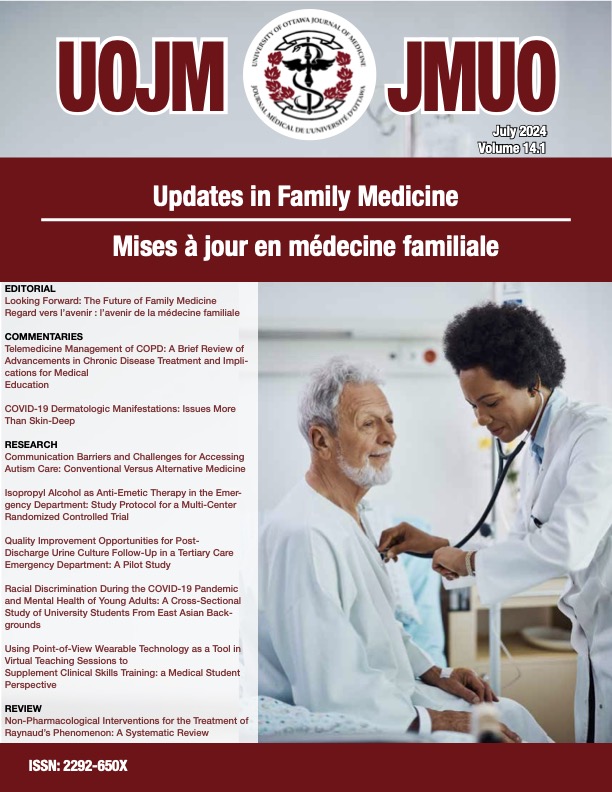Telemedicine Management of COPD: Advancements in Chronic Disease Treatment and Implications for Medical Education
DOI:
https://doi.org/10.18192/uojm.v13i01.6463Keywords:
Telemedicine, Medical Education, COPD, Curriculum, COVID-19Abstract
Social determinants of health are non-medical, social and economic factors that influence health. The practice of telemedicine enables physicians to virtually connect patients with healthcare resources. Throughout the COVID-19 pandemic, healthcare providers have increasingly utilized telemedicine as a method to provide appropriate care to patients with chronic diseases, including Chronic Obstructive Pulmonary Disease (COPD). COPD is a progressive obstructive lung disorder which is substantially impacted by social determinants of health including access to healthcare. The successful utilization of telemedicine in the care of patients with chronic diseases, including COPD, highlights its emerging importance in healthcare. However, many Canadian medical schools have yet to implement a formalized telemedicine curriculum, and most Canadian students do not feel adequately prepared for virtual healthcare delivery. Here, we outline the utilization of telemedicine in COPD management and advocate for the rapid introduction of a formalized telemedicine curriculum at the undergraduate and postgraduate levels.
References
Canada Health Act, RSC 1985, c C-6, retrieved on 2022-04-28.
Gore D, Kothari A. Social determinants of health in Canada: are healthy living initiatives there yet? A policy analysis. Int J Equity Health. 2012 Aug 14;11:41.
Crighton EJ, Ragetlie R, Luo J, To T, Gershon A. A spatial analysis of COPD prevalence, incidence, mortality and health service use in Ontario. Health Rep. 2015 Mar;26(3):10–8.
Ekeland AG, Bowes A, Flottorp S. Effectiveness of telemedicine: a systematic review of reviews. Int J Med Inform. 2010 Nov;79(11):736–71.
Koonin LM, Hoots B, Tsang CA, Leroy Z, Farris K, Jolly T, et al. Trends in the Use of Telehealth During the Emergence of the COVID-19 Pandemic - United States, January-March 2020. MMWR Morb Mortal Wkly Rep. 2020 Oct 30;69(43):1595–9.
Canadian Medical Association. What Canadians think about virtual health care [Internet]. 2020 [cited 2022 Jun 4]. Available from: https://www.cma.ca/sites/default/files/pdf/virtual-care/cma-virtual-care-public-poll-june-2020-e.pdf
Canadian Medical Association. 2021 National Survey of Canadian Physicians. 2021 Aug. Report No.: https://www.infoway-inforoute.ca/en/component/edocman/3935-2021-national-survey-of-canadian-physicians/view-document?Itemid=0.
Gershon AS, Guan J, Victor JC, Goldstein R, To T. Quantifying health services use for chronic obstructive pulmonary disease. Am J Respir Crit Care Med. 2013 Mar 15;187(6):596–601.
Burkes RM, Gassett AJ, Ceppe AS, Anderson W, O’Neal WK, Woodruff PG, et al. Rural Residence and Chronic Obstructive Pulmonary Disease Exacerbations. Analysis of the SPIROMICS Cohort. Ann Am Thorac Soc. 2018 Jul;15(7):808–16.
Sculley JA, Musick H, Krishnan JA. Telehealth in chronic obstructive pulmonary disease: before, during, and after the coronavirus disease 2019 pandemic. Curr Opin Pulm Med. 2022 Mar 1;28(2):93–8.
Mohammed HT, Hyseni L, Bui V, Gerritsen B, Fuller K, Sung J, et al. Exploring the use and challenges of implementing virtual visits during COVID-19 in primary care and lessons for sustained use. PLoS One. 2021 Jun 24;16(6):e0253665.
Miner H, Fatehi A, Ring D, Reichenberg JS. Clinician Telemedicine Perceptions During the COVID-19 Pandemic. Telemed J E Health. 2021 May;27(5):508–12.
Global Initiative for Chronic Obstructive Lung Disease. GOLD Pocket Guide 2019. 1–49 (2019).
Mínguez Clemente P, Pascual-Carrasco M, Mata Hernández C, Malo de Molina R, Arvelo LA, Cadavid B, et al. Follow-up with Telemedicine in Early Discharge for COPD Exacerbations: Randomized Clinical Trial (TELEMEDCOPD-Trial). COPD: Journal of Chronic Obstructive Pulmonary Disease. 2021 Jan 2;18(1):62–9.
Press VG, Arora VM, Kelly CA, Carey KA, White SR, Wan W. Effectiveness of Virtual vs In-Person Inhaler Education for Hospitalized Patients With Obstructive Lung Disease: A Randomized Clinical Trial. JAMA Netw Open. 2020 Jan 3;3(1):e1918205.
Waseh S, Dicker AP. Telemedicine Training in Undergraduate Medical Education: Mixed-Methods Review. JMIR Med Educ. 2019 Apr 8;5(1):e12515.
Lehrer, Murray, Adler, Haerter. Telemedicine education for undergraduate medical students. Meeting of Keck School of Medicine of the. 2016;
Pathipati AS, Azad TD, Jethwani K. Telemedical Education: Training Digital Natives in Telemedicine. J Med Internet Res. 2016 Jul 12;18(7):e193.
Downloads
Published
Issue
Section
License
Copyright (c) 2023 Mario Corrado, Shaun Andrew Hanycz

This work is licensed under a Creative Commons Attribution-NonCommercial-NoDerivatives 4.0 International License.
- Authors publishing in the UOJM retain copyright of their articles, including all the drafts and the final published version in the journal.
- While UOJM does not retain any rights to the articles submitted, by agreeing to publish in UOJM, authors are granting the journal right of first publication and distribution rights of their articles.
- Authors are free to submit their works to other publications, including journals, institutional repositories or books, with an acknowledgment of its initial publication in UOJM.
- Copies of UOJM are distributed both in print and online, and all materials will be publicly available online. The journal holds no legal responsibility as to how these materials will be used by the public.
- Please ensure that all authors, co-authors and investigators have read and agree to these terms.
- Works are licensed under a Creative Commons Attribution-NonCommercial-NoDerivatives 4.0 International License.


